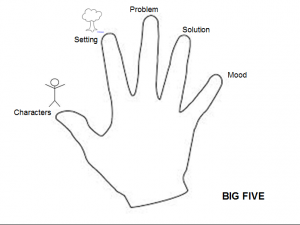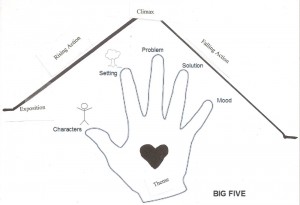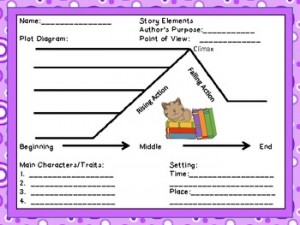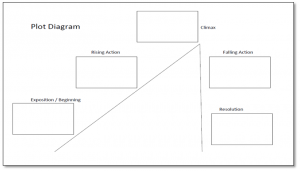I had a great question from a good friend:
“Why does it matter if students see or understand rising and falling action?”
My answer is–it doesn’t AND it does!
Understanding the author’s craft in writing a story helps a child begin to make predictions that make sense. We read predictable text for students in K-2 for a reason–for them to get an understanding of how stories are structured and that most stories have a problem and at the end–they solve it. In 3-5 the stories become more complex with multiple problems and solutions–by understanding how an author creates a story–it helps them see that sometimes an extra problem is the author’s way of building suspense–it is not meant to be solved. It is not important the students can call these by name but to notice that these techniques are used to enhance and make a story interesting. It is these techniques that make a story with reading AND more complicated. So, do they need to call them by name? No, but should they understand how a story is structured–ABSOLUTELY!
So–here is the breakdown of 3-5 elements and their importance. Remember–every time our students recognize an author’s technique–they are seeing how the story is structured and the why behind it–leading to deeper comprehension.
Exposition:
Exposition is when the scene is set and background information is provided. This part of the story is getting the reader ready for the story. It is building the background necessary for the story to take place. Students often go into automatic pilot as they read this part of the story but this is where subtle clues foreshadows and inferences about the character take place. The setting helps set the mood of the story and helps the reader make inferences to the character. The character introductions help the reader make connections to the characters and the setting–Why are they there? What are they doing? How are they acting?
Characters:
We often talk about round and flat characters to help student begin to distinguish how an author “creates” the character and their personality for the reader. Flat characters are often our secondary or supporting characters we do not learn much about. Round characters are fully developed characters that have many facets of a personality and reactions in situations.
As students get older–introducing the idea of an antagonist and protagonist adds a deeper dimension to understanding the character. The protagonist is often the hero or main character and the antagonist is the “bad guy” or person who puts pressure on the protagonist. This helps students see how characters are similar and different as well as to look at a person’s motivation for why they do what they do.
This is a great blog that shares techniques to teach characterization. It even includes static and dynamic characters.
This would be a K-2 example of characterization:

This would be an example of 3-5:

Rising and Falling Action:
In the 19th century, there was a German novelist named Gustav Freytag who created a story plot pyramid to show common patterns in stories and novels.

This graphic was taken from: http://www.ohio.edu/people/hartleyg/ref/fiction/freytag.html
Rising action are the events leading to the Climax of the story–this is where the author will often use the pattern of 3 to build suspense or have alternate problems that lead no where to keep the reader guessing. When students know this pattern, they can begin to sift through what is important or relevant details and irrelevant. They can also see when a critical event is about to happen.
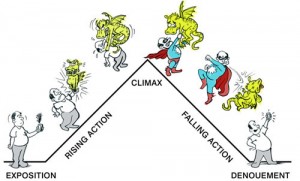 I like to show students this visual .
I like to show students this visual .
Falling action allows the reader to know the solution is near. It helps them see how an author begins to close out a story and all loose ends are being tied up.
Video Clips to help teach Plot Structure
Foreshadow and Flashback:

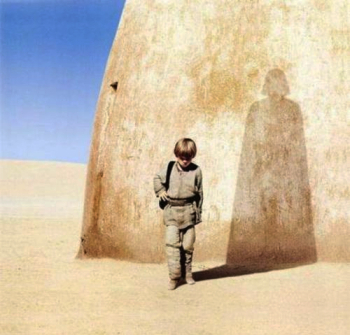 Understanding and seeing foreshadow will help students pick up on subtle hints that something is going to happen or a future event. This help students make predictions AND to learn to find small details and make connections and inferences. Flashback is a technique used to stop current events and have a reader go back in time to build background or see a past event. This is tough for students who are not proficient readers because they do not realize that the event is not currently happening. Teaching this to students helps them learn how to sequence events. It also helps students make connections between more than one character, events and settings.
Understanding and seeing foreshadow will help students pick up on subtle hints that something is going to happen or a future event. This help students make predictions AND to learn to find small details and make connections and inferences. Flashback is a technique used to stop current events and have a reader go back in time to build background or see a past event. This is tough for students who are not proficient readers because they do not realize that the event is not currently happening. Teaching this to students helps them learn how to sequence events. It also helps students make connections between more than one character, events and settings.

Books to help you teach foreshadow/flashback
The Stranger Chris Van Allsburg
Miss Rumphius by Barbara Cooney
Why the Chicken Crossed the Road by David Macaulay
House on Maple Street by Bonnie Pryor
Video Ideas
Video for Class Discussion–play and stop often
Review of many techniques Video
In closing, it is important for students to dig deep into the text for understanding. The more they know about how something is organized and crafted–the easier it is for them to see the parts of the whole.
